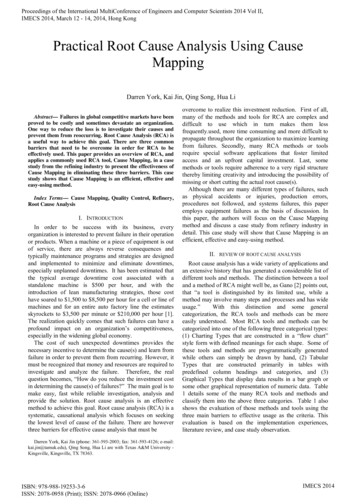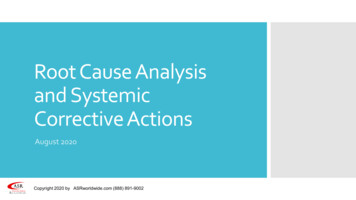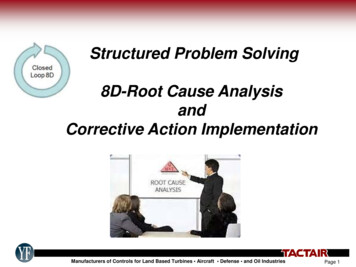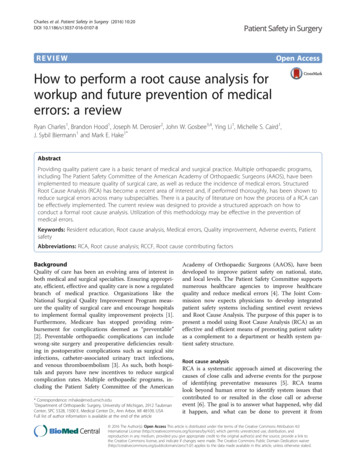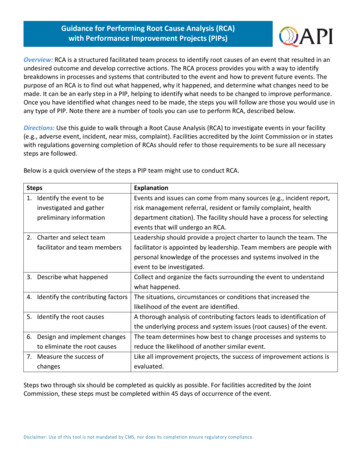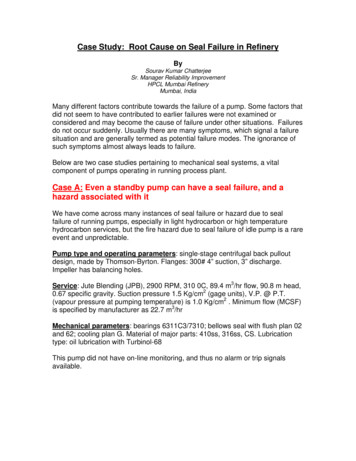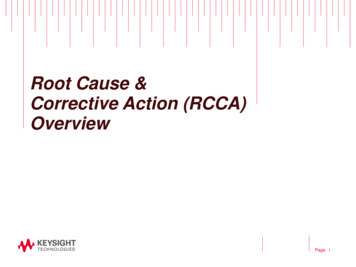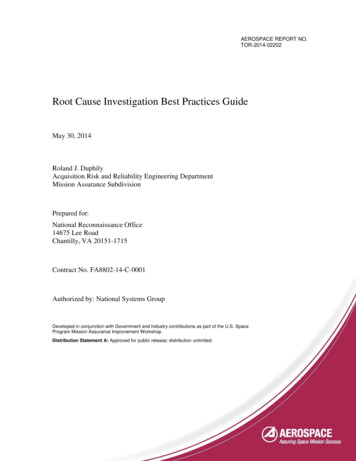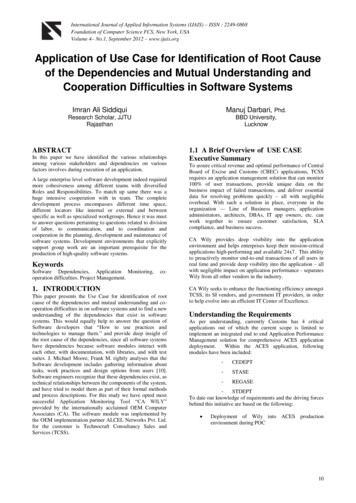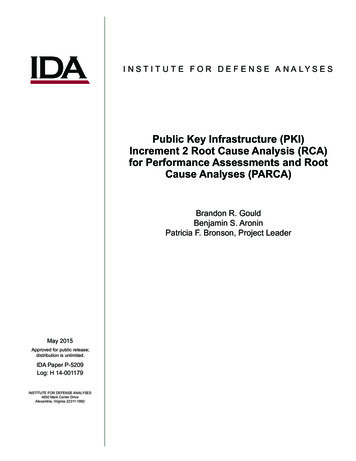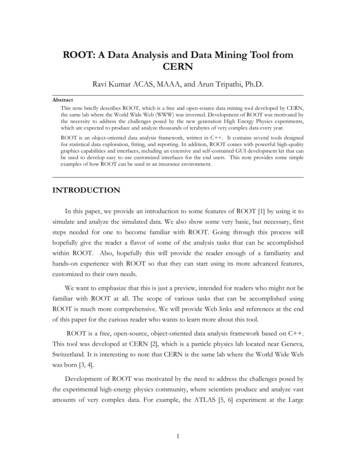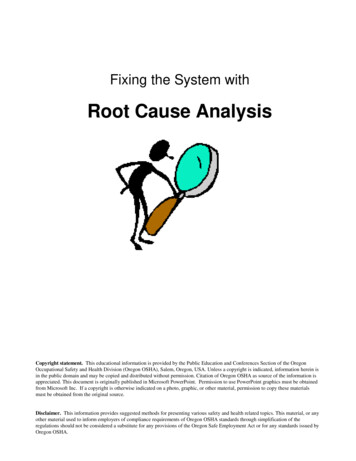
Transcription
Fixing the System withRoot Cause AnalysisCopyright statement. This educational information is provided by the Public Education and Conferences Section of the OregonOccupational Safety and Health Division (Oregon OSHA), Salem, Oregon, USA. Unless a copyright is indicated, information herein isin the public domain and may be copied and distributed without permission. Citation of Oregon OSHA as source of the information isappreciated. This document is originally published in Microsoft PowerPoint. Permission to use PowerPoint graphics must be obtainedfrom Microsoft Inc. If a copyright is otherwise indicated on a photo, graphic, or other material, permission to copy these materialsmust be obtained from the original source.Disclaimer. This information provides suggested methods for presenting various safety and health related topics. This material, or anyother material used to inform employers of compliance requirements of Oregon OSHA standards through simplification of theregulations should not be considered a substitute for any provisions of the Oregon Safe Employment Act or for any standards issued byOregon OSHA.
Get to the roots to fix the systemThe hazardous conditions and unsafe behaviors we identify as contributing to the accident are calledthe surface causes of the accident. After we identify surface causes, we'll need to determine ifinadequate safety system components contributed to the accident by allowing the hazardousconditions and unsafe behaviors to develop or occur. These system inadequacies are called the rootcauses of accidents. Let's take a closer look at these two very important concepts.The surface causes of accidentsThe surfaces causes of accidents are those hazardous conditions and unsafe employee/managerbehaviors and activities that have directly caused or contributed in some way to the accident.Hazardous conditions: are basically things or objects that cause injury or illness may also be thought to be defects in a process may exist at any level of the organizationHazardous conditions may exist in any of the following imeIt's important to know that most hazardous conditions in the workplace are the result of an unsafebehaviors that produced them.Unsafe behaviors: are actions we take or don't take that increase risk of injury or illness. may also be thought to be errors in a process may occur at any level of the organization.Some example of unsafe employee/manager behaviors include:Failing to comply with rulesUsing unsafe methodsTaking shortcutsFailing to report injuriesFailing to report hazardsHorseplayAllowing unsafe behaviorsFailing to trainFailing to superviseScheduling too much workIgnoring worker stressFailing to correct
The direct cause of injury is not the cause of the accidentIf we examine the surface cause categories above, we find that each may somehow produce aharmful level of energy that may be transferred to our body directly causing an injury. The harmfultransfer of energy is the direct cause of injury. Let's take a look at three examples: If a harsh acid splashes on our face, we may suffer a chemical burn because our skin has beenexposed to a chemical form of energy that destroys tissue. In this instance, the direct cause ofthe injury is harmful a chemical reaction. The related surface cause might be the acid(condition) or working without proper face protection (unsafe behavior). If our workload is to too strenuous, force requirements on our body may cause a muscle strain.Here, the direct cause of injury is a harmful level of kinetic energy (energy resulting frommotion), causing injury muscle tissue. A related surface cause of the accident might be fatigue(hazardous condition) or improper lifting techniques (unsafe behavior).The important point to remember here is that the "direct cause of injury" is not the same asthe surface cause of the accident. To summarize: The surface cause of the accident describes a condition or behavior. The result of the conditionand/or behavior is the direct cause of injury.a harmful transfer of energy. The direct cause of injury is the harmful transfer of energy. The direct result is injury.Safety Engineering & Safety Management two different rolesSafety "engineers" closely analyze all the surface cause categories and attempt to (1) eliminate theharmful energy, (2) reduce the harmful energy transfer, or (3) reduce exposure to harmful energytransfer. They do this by designing safety features directly into tools, machinery, equipment,facilities, etc.On the other hand, safety “managers” identify and analyze the safety management system to evaluatethe effectiveness of its subsystem components. They improve the system to eliminate or reduce thecommon or root causes producing the hazardous conditions and behaviors.Workplace safety is most successful when engineering controls and management systemimprovement compliment each other.
The root causes of accidentsThe root causes for accidents are the underlying safety system weaknesses that have somehowcontributed to the existence of hazardous conditions and unsafe behaviors that represent surfacescauses of accidents.It's important to understand that root causes always pre-exist surface causes. Indeed, inadequatelydesigned system components have the potential to feed and nurture hazardous conditions and unsafebehaviors. If root causes are left unchecked, surface causes will flourish!Examples of safety system functions and the components common to all systemsinclude:Safety systems: Systems are developed to:Promote Commitment/leadershipIncrease employee involvementEstablish accountabilityIdentify and control hazardsInvestigate incidents/accidentsEducate and trainEvaluate the safety programSystem sBudgetsReportsRulesSafety managers work with safety engineers to eliminate or reduce exposure to hazards througheffectively improving safety system components. Because systems design work common throughoutthe workplace, eliminating any single root cause may simultaneously eliminate many hazardousconditions and unsafe behaviors.Since root causes reside within safety management systems, upper management -- those whoformulate systems, are most likely going to be involved in making the necessary improvements.When analyzing for system weaknesses, it may be beneficial to coordinate closely with those whowill be responsible for implementing system improvements.
Three levels of cause analysisAs mentioned earlier in the course, accidents are processes that culminate in an injury or illness. Anaccident may be the result of many factors (simultaneous, interconnected, cross linked events) thathave interacted in some dynamic way. In an effective accident investigation, the investigator willconduct three levels of of cause analysis:Injury analysis. At this level of analysis, we do not attempt to determine what caused the accident,but rather we focus on trying to determine how harmful energy transfer caused the injury.Remember, the outcome of the accident process is an injury.Event Analysis. Here we determine the surface cause(s) for the accident: Those hazardousconditions and unsafe behaviors described throughout all events that dynamically interact to producethe injury. All hazardous conditions and unsafe behaviors are clues pointing to possible systemweaknesses. This level of investigation is also called "special cause" analysis because the analyst canpoint to a specific thing or behavior.Systems analysis. At this level we're analyzing the root causes contributing to the accident. Wecan usually trace surface causes to inadequate safety policies, programs, plans, processes, orprocedures. Root causes always pre-exist surface causes and may function through poor componentdesign to allow, promote, encourage, or even require systems that result in hazardous conditions andunsafe behaviors. This level of investigation is also called "common cause" analysis because wepoint to a system component that may contribute to common conditions and behaviors throughout thecompany.The biggest challenge to effective accident investigation is to transition from eventanalysis to systems analysis.One last important point to make is that most accident processes are far more complex than we mightoriginally think. Some experts believe at least 10 or more factors come together to cause a seriousinjury. Other experts state that, on average, 27 factors directly and indirectly contribute to seriousaccidents.Only by thoroughly conducting all three levels of analysis can we design system improvements thateffectively eliminate hazardous conditions and unsafe behaviors at all levels of the organization. Theaccident investigation can not serve as a proactive safety process unless system improvementseffectively prevent future accidents.Fix the system not the blame
The Accident WeedInjury orIllnessDirect Cause of InjuryStrains Harmful Energy Transfer Kinetic, thermal, chemical, hemical sIgnorepillya hazardrda hazaryinjuporters toFailDefectivePPEUntrainedlasepFails to inspectworkerFails to enforceLack of timePrimary Surface Causes Directly cause of the injury eventUnique hazardous condition(s)Individual unsafe behavior(s)Controllable or uncontrollable factorsEvents occur close to the injury eventFailure to perform safety practices,procedures, processes Involves the victim, othersSecondary Surface Causes Indirectly cause the injury eventSpecific hazardous condition(s)Individual unsafe behavior(s)Controllable and uncontrollable factorsEvents occur distant from the injury eventFailure to perform safety practices,procedures, processes Co-workers, supervisors, anytime, anywhereImplementation Root CausesFails to trainInadequate trainingNo discipline proceduresNo orientation processInadequate training planNo accountability policyLack of vision No mission statementworkTo muchNo recognitionInadequate labelingOutdated hazcom programNo recognition planNo inspection policy Common conditions and behaviors Inadequate implementation of safety policies,programs, plans Inadequate design of processes, procedures Pre-exist surface causes Controllable Middle management, anytime, anywhereSystem Design Root Causes Inadequate design of safety system policies,programs, plans Pre-exist all other causes Controllable CEO, top management, anytime, anywhereExternal Environmental Causes Government regulationPhysical resourcesHuman resourcesCapitalSociety
Team Exercise: “Getting to the roots by asking why, why, why, why”Purpose: Now that you have reconstructed the specific events prior to, during, and after theaccident, it’s time to analyze for cause by asking a series of "Whys."Instructions.1. Analyze the injury event to identify and describe the direct cause of injury. Seeexamples below.a. Describe the injury and it’s cause. Laceration to right forearm resulting from contact with rotating saw blade.Contusion from head striking against/impacting concrete floor.Burn injury to right lower leg from contact by battery acid.Impact following a fall from platform to lower level caused dislocation of right shoulder.b. Identify the accident ily reactionContact-withFall-to-surfaceExposure.Write the direct cause for the injury below.List the accident type.
Team Exercise: “Getting to the roots by asking why, why, why, why”2. Analyze at least two events occurring just prior to the injury event to identifysurface causes for the accident.a. Determine the primary surface causes. Look for specific hazardous conditions andemployee behaviors that caused the injury. Event x. Unguarded saw blade. (condition or behavior?) Event x. Working at elevation without proper fall protection. (condition or behavior?) Event x. Employee unaware of hazards of working with batteries. (condition or behavior?)Condition(s)Behavior(s)a. Determine secondary surface causes. These are also specific conditions and behaviors. Supervisor not performing weekly area safety inspection. (condition or behavior?) Fall protection equipment missing. (condition or behavior?) Responsible person not training on how to hook up harness. (condition or behavior?)Condition(s)Behavior(s)
Team Exercise: “Getting to the roots by asking why, why, why, why”3. Analyze each surface cause to identify potential root cause(s) that contributed to orproduced the accident.a. Determine system implementation weaknesses. Look for the common behaviors thatrepresent inadequate implementation of safety programs and processes. It’s important tounderstand that poor implementation of one program area may be the result of poorimplementation in another safety management program area:Top management commitmentAccountabilityEmployee involvementHazard identification & controlIncident & Accident Investigation Education & TrainingSafety system evaluation Safety inspections are being conducted inconsistently.Safety is not being adequately addressed during new employee orientation.Supervisors are not enforcing safety rules.Implementation Root Causesa. Determine system design weaknesses. Then ask why to determine the inadequate/missingpolicies and plans that caused them. These are common conditions. Inspection policy does not clearly specify responsibility by name or position.No fall protection training plan or process in place.Procedures for administering corrective actions absent from the accountability plan.System Design Root Causes
Determine the causesDirect Cause of injury- A harmful transfer ofenergy that produces injury or illness.Surface Causes of accident - Specifichazardous conditions or unsafe behaviors thatresult in an accident.Root Causes of the accident - Commonbehaviors and conditions that ultimately result
Root Cause Analysis. Get to the roots to fix the system The hazardous conditions and unsafe behaviors we identify as contributing to the accident are called the surface causesof the accident. After we identify surface causes, we'll need to determine if inadequate safety system components contributed to the accident by allowing the hazardous conditions and unsafe behaviors to develop or occur .
